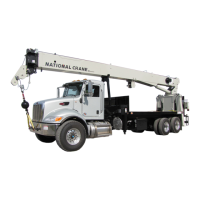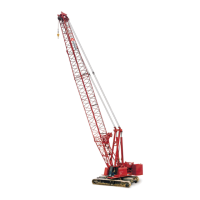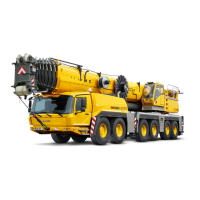SAFETY INFORMATION 999 LUFFING JIB OPERATOR MANUAL
2-8
Published 05-15-17, Control # 043-09
8. Operator shall not start crane movement if the load or
designated signal person is not within his/her range of
vision or communication.
9. The operator shall understand and respond to signals
from the person directing the lift or from the designated
signal person. When a signal person or crane follower is
not required, the operator is responsible for lift.
Operator shall obey a stop signal at all times, no
matter who gives it.
10. Operator shall verify that the capacity chart being used
is the correct one for how the crane is equipped (boom
length, load line reeving, counterweight, etc.).
11. Operator shall verify that:
a. All attachments are properly assembled and
attached to the crane according to the rigging
drawings called for on the capacity chart.
b. The counterweight — to include applicable auxiliary
counterweight — is in place and of proper weight.
Maximum required counterweight must not be
exceeded.
12. Operator shall perform the following operations before
leaving operator’s cab for any reason:
a. Park crane and position upperworks so crane does
not interfere with operation of other equipment.
b. Apply travel and swing brakes or locking devices.
c. Land any attached load.
d. Lower boom onto blocking at ground level or onto a
boom rest if possible.
If the boom cannot be lowered, as determined by a
qualified designated person, it must be securely
fastened from movement by wind or other outside
forces (see Wind Conditions in Capacity Chart
Manual).
NOTE: The designated person shall be familiar with the job
site limitations, the crane configuration, and the
expected weather conditions.
e. Move all controls to off.
f. Apply all drum brakes and pawls.
g. Disengage master clutch, if equipped.
h. Stop engine.
NOTE: Also read Unattended Crane instructions in Section
3 of the Crane Operator Manual.
13. The operator shall perform the following operations if
power or a control function fails during operation:
a. Land all suspended loads, if possible, under brake
or power control.
b. Apply all brakes and locking devices.
c. Move all controls to off.
14. If the crane will be operated at night, the operator shall
make sure that there is sufficient lighting for safe
operation. The load and landing area must be
illuminated.
15. The operator shall not operate the crane during periods
of bad weather if his/her ability to see the load or the
signal person is impaired by darkness, fog, rain, snow,
and the like.
Do not operate the crane with a snow or ice covered
boom. The extra weight may cause overload, tipping, or
structural damage.
Never operate the crane during an electrical
thunderstorm.
When a local weather storm warning exists (including
electrical thunderstorm), stop operation and secure the
crane. See step 12
under Operator Conduct topic.
NOTE: DO NOT depend on grounding. Grounding of a
crane affords little or no protection from electrical
WARNING
Safety devices and operational aids such as rated
capacity indicator or limiter, boom and jib angle indicator
or limiter, anti-two-block device, level indicator, swing
limiter, proximity device, etc., may be installed on your
crane. Such devices are to be used only as AIDS TO
ASSIST OPERATOR - their presence on crane in no way
substitutes for or lessens requirement that operator
knowledge, experience, and judgment are required to
ensure safe operation of crane.
Crane must not be loaded beyond applicable static or
dynamic ratings given on capacity chart for crane.
• See Size of Load later in this section.
• For a description of each safety device and
operational aid, see Safety Devices and Operational
Aids in this section and Section 3.
WARNING
Moving Load/Tipping Crane Hazard!
Changing weather conditions including but not limited to:
wind, ice or snow accumulation, precipitation, flooding,
lightning, etc. should be considered when determining the
location and configuration of a crane when it will be left
unattended.
